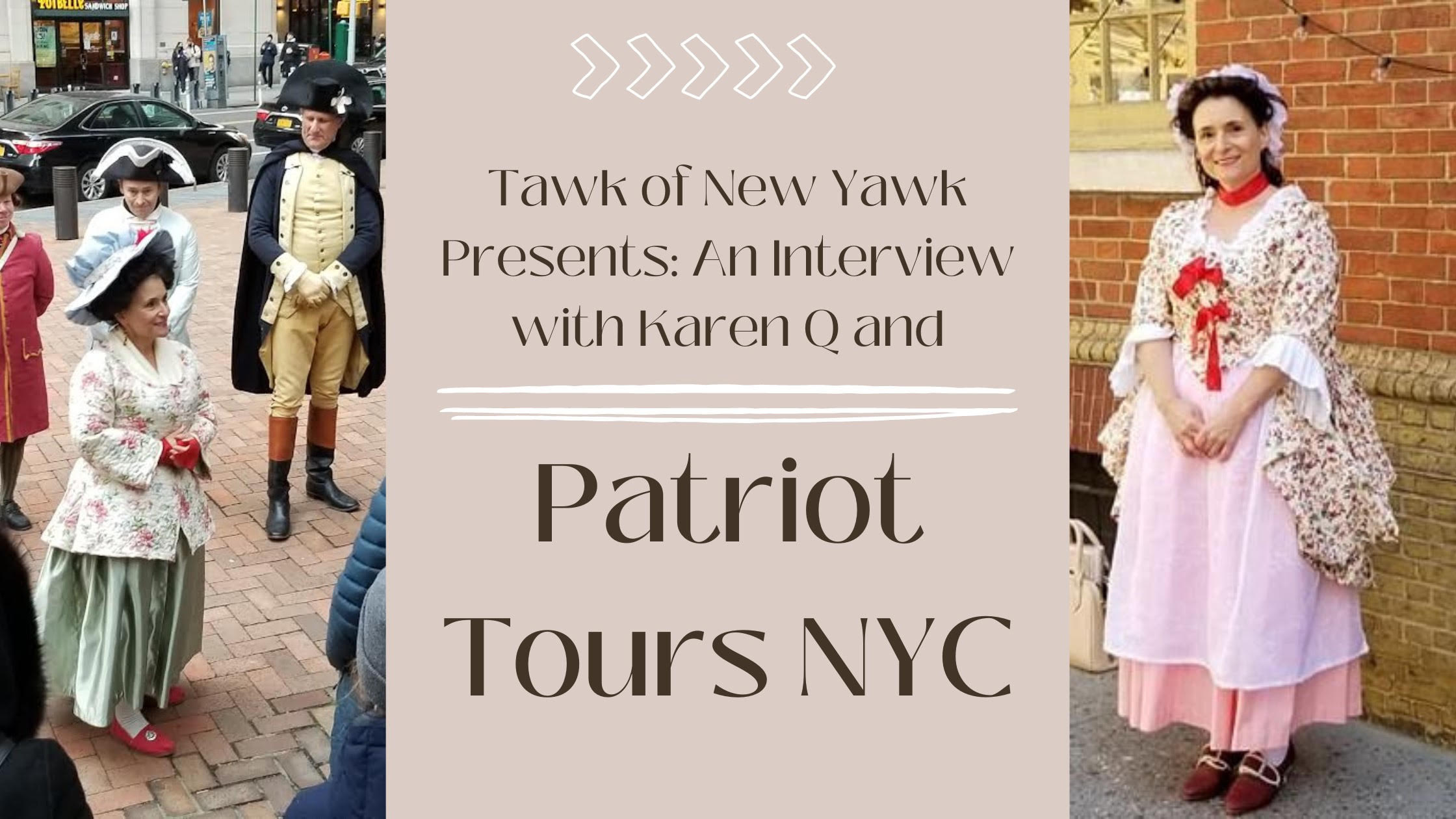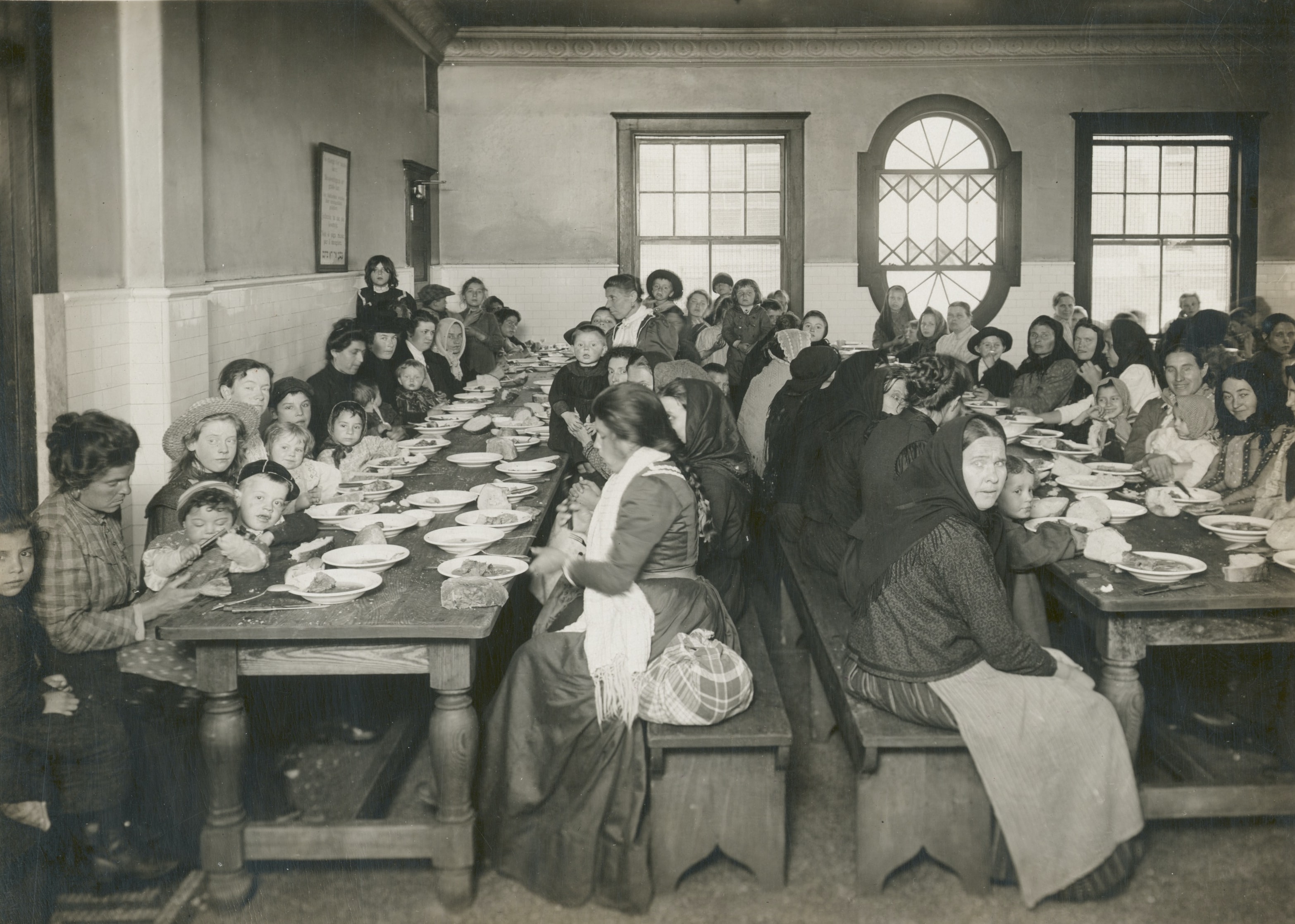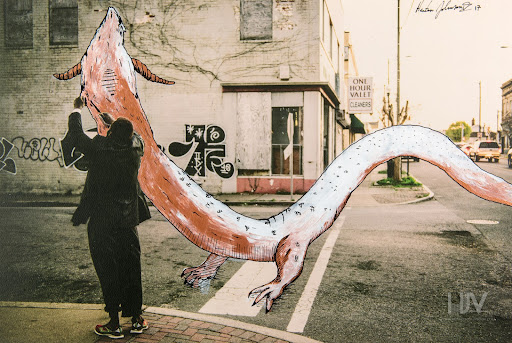
It’s a bright, clear September morning when I meet Karen Quinones out front of Saints Paul’s Chapel on Wall Street. She’s holding a sign for her tour, Patriot Tours, but today she’s not dressed as her titular character, Revolutionary War Patriot, Mrs. Q.
Karen leads me toward the back of the chapel and to a nice park bench overlooking the cemetery. We are on the Hudson side of the chapel because it’s the original entrance. When it was built the Chapel was on the river. Most of the World Trade Center land is a landfill.
We sit, and she tells me about her tour company specializing in New York City Revolutionary History. Karen Q started giving tours just before the COVID 19 Pandemic and is also an avid reenactor. She performs as her patriot character, Mrs. Q. of Hanover Street.

Dia: How did you get involved in history and specifically the American Revolution?
Karen: I left my stressful job on Wall Street and went back to something I always enjoyed; reading original stories about the American Revolution. What actually happened? What did people of the time say happened? New York is an incredible repository of thousands and thousands of documents. I spent just a couple of years doing that and found out that the story I thought about the American Revolution is shallow. What we learn is just touching the surface about what the war was really about and what the Revolution was really about. I didn’t know anything about those real people because we always just learn about the big names. But what was it like for ordinary people at that time? People just going about their business, going about their time and trying to survive here?
Karen Q. tells me that just as she was about to return to her job, a colleague suggested that she start a tour. After some hesitation, she leaped in 2005. Almost a decade later, it has opened doors she never dreamed of, such as radio shows, consultant work, appearing on Travel Channel’s Mysteries at the Museum, and the creation of the character Mrs. Q.
Karen: During the pandemic, I started doing a Friday night live stream as my 18th-century character Mrs. Q of Hanover Street. She is a lady and a merchant here in colonial New York City. The stream is all about her life as a Wig (or Rebel) during the Revolutionary period. It did so well that when I started going to reenactments as Mrs. Q people would start running up to me and say, “It’s Mrs. Q!” I didn’t know how to react to that because I didn’t know people were watching the stream. But everywhere I go as Mrs. Q people who are into the American Revolution recognize me. It’s a lot of fun.
https://www.youtube.com/watch?v=H56wk5ah34o&feature=emb_title
Dia: How long have you been doing reenacting?
Karen: I got involved three years ago because of a good friend, Kyle Jenks who is a tour guide in Philadelphia. He’s one of the most highly esteemed James Madison portrayers in America. I did a July 4th tour, and he was appearing with gentlemen who play Hamilton and Jay at Federal Hall as the authors of the Federalist papers. After my July 4th tour I took my whole group to meet Hamilton, Madison and Jay at Federal Hall. And in the course of the conversation Kyle told me he’d be in NYC in November for Evacuation Day, but as his loyalist character, James Akerman. Kyle said, “I think you should show up as a Patriot lady and give me the “what for.”
At first, Karen disagreed, vowing she would never do something like that, but the idea wouldn’t leave. Finally, she decided to create a rebel character, dress up, go to the Evacuation Day Reenactment, and give the departing British a piece of her mind.
Karen: When I showed up in costume for the first time, people were enthralled. Because usually, when you go to these reenactments, it’s all men in their military uniforms or suits and the tri-corner hats. But when they saw a full-blown lady standing there, they couldn’t believe it. Everybody crowded around me to find out what my clothes meant or what they were made of. Little girls kept asking me if I was a princess or a queen. I realized there was something about being a history interpreter and actually inhabiting that character. That was the birth of Mrs. Q of Hanover S.
Karen continued to tell me about Mrs. Q of Hanover Street. She talked more about her live stream as Mrs. Q. during the pandemic. Karen talks about all things American Revolution. She talks about what a Wig/Rebel woman would have thought about the war and the experiences of her friends and family. Most importantly, she talks about the gossip Mrs. Q would have heard at her Fine Lady’s shop.
Karen: All the stories are based on real letters and primary source documents. I don’t make any of it up. Its all true. Well, true gossip.
We laugh about the fact that gossip has survived for hundreds of years. Life hasn’t changed much in that regard.
Dia: What is the importance of the work you are doing? What do you want people to take away when they come on your tours or meet Mrs. Q?
Karen: I think what I’ve been trying to do from the beginning is first tell people all the things they didn’t learn about the American Revolution and the causes behind it, which are based very much in London. There’s a whole part of the story we don’t get, and I try to add some of that into my tours to give it some context. But I think my real mission is to show the personal stories of the American Revolution. For instance, we are sitting here in Saint Paul’s Graveyard, and not far us is a gentleman I talk about on both tours. His name is John Holt. He was a printer. He printed some of the most incendiary material leading up to the Revolutionary War, including a 17 installment paper. It was found many years later and admitted that it was written by a young student at Kings Collage – Alexander Hamilton. So John Holt lived his life here. He had to flee New York with his life in 1776 but returned after the war started. When he passed away of natural causes, he was virtually a pauper, but he was rich in esteem and honor for the risks he took on behalf of the American Revolution.
Karen: Or people like Elizabeth Bergan who most people know nothing about. Many people know that there were prison ships docked in the East River on the Brooklyn Side as well as prisons here in New York City as it is occupied by the British. It’s believed that Elizabeth Bergan rescued almost 200 prisoners from New York and brought them to safety in New Jersey, risking her life in doing so. She was a peddle woman. She would use her peddler boat to hide prisoners in. She covered them up and took them to New Jersey. Eventually, the British got wind of what she was doing, and she fled New York. She left her children here and went on to Philadelphia. Eventually, she was reunited with her children, and George Washington granted her a lifetime pension for what she did. That’s part of the way we know what she did. She didn’t talk about it, but we find it in the papers of general Washington. And other officers who gave her the commendation. When she received the pension, she asked Washington, “What do you want me to do to work for this?” He said, “You don’t have to do anything. You’ve served the cause enough.” In response, she said, “A person should never receive payment without work.” And she spent the rest of the war-making the tunics, (the undergarments) the men wore as soldiers.
Karen: There are so many historic spots. There’s the old reformed church of Staten Island which was the home church of the Mersereau brothers, who operated a great spy ring in New Jersey. So a lot of people know about the Culper Ring operating from Manhattan to Long Island. But over in New Jersey, the Mersereau family was running another spy ring. Anyway, at the conference house in Staten island — a meeting was held to try to form an armistice so the Revolutionary war wouldn’t happen.
Dia: Wow, that would have been so different.
Karen: Obviously a failed meeting. It’s because Congress sent three of the worst radicals to that meeting, John Adams, Benjamin Franklin and Edward Rutledge. They were pretty much going to be intractable in their views so that meeting was a failure in I think the first ten or fifteen minutes.
Dia: We forget that our country was formed by quite radical individuals.
Karen: We do forget about it. And there’s a great book called “Radicalism of the American Revolution” by Gordan S. Wood which talks about how very radical these men and women were. We hear about all of these people, Hamilton, Madison, Jay all very important people. But we don’t hear about John Jay’s wife. His incredible wife, Sarah Livingston Jay. The Livingstons are an extremely important New York Family. Her father was William Livingston, probably the greatest lawyer in the New York/New Jersey area in the Revolutionary War period. And because her father was who he was, she was a very well-educated lady. She married John Jay, another well-educated young man. When Jay served as a diplomat during the war he credited his wife’s intellect, social graces and beauty for a lot of his diplomatic successes in Europe. There’s one story, I have no idea if it’s true, but it was perpetuated that one night they were in the opera in Paris and that she looked so beautiful that people thought she was Queen Maria Antoinette. People stood up and bowed to her in her box. Of course, after the war she is key in NYC when we’re the capital city and her husband is Chief Justice. She was responsible for holding these very important dinners, and banquets and getting the right people in the right room for things to be accomplished
Dia: Were women like her why you wrote your book about Theodosia Burr?
Karen: In part. I was really fascinated with – a lot of people get angry at this—in many ways, Aaron Burr was the more fascinating character because his public life and her personal life were so different. The public Burr vs the private Burr. I got interested when I learned that Arron Burr really believed that women were capable of the same intellectual achievements as men. He talks about this, and he thought this from the time he was a child. He thought the reason we never saw it was the fault of education and that we didn’t educate our daughters. As the years went by he started thinking that intellectual women were a childhood fantasy, something he desired that would never be true, until he met the woman who became his wife, Theodosia Burr, who was a great intellectual in her own right. And when he met her, he knew it was true. Together they set out to raise their daughter as a first-born son, which was highly controversial. Actually, their townhome was right across the street from where we are sitting. They set out to educate their daughter, also named Theodosia, the same as firstborn sons in New York. So that would be the same as Philip Hamilton and Washington Irving. I was also intrigued that Burr read Mary Wollstonecraft’s A Vindication of the Rights of Woman. She was Mary Shelly the author of Frankenstein’s mother. Very controversial lady. He read it and sent it to his wife to read. And I was so intrigued by the personal Burr that I set to find out the story and relationship with his daughter. He became a single father when she was 12. And really, the mastermind behind her education which would equal that of a Princeton graduate of that time.
And she’s [Theodosia] an inspiration. She’s still an inspiration to teenagers today because at the time she was being raised, she was an outcast in many ways. She wasn’t sewing, she wasn’t learning the small talk that women would learn in order to socialize. She was reading Latin and Greek. She was studying the classics, history and geography. She becomes a teenage outcast, as so many people are used to being. You can see in my book I have a letter from her father where she has written that she’s depressed. She is around 15. And he says, “you should never feel depressed because in my eyes, you are spectacular. And you always will be.” You see this loving father trying to help his daughter through some of the difficulties she faces as being the only young woman in New York of her kind and having trouble in female society. I see her as an inspiration today for teenagers who are going through those difficult transitions and trying to establish themselves as individuals in a sea pushing against them.
Dia: Can you paint a picture of what life would have been like in New York City during the Revolution? Obviously, it would have split the community quite drastically.
Karen laughs.
Karen: Oh, I do some of this as Mrs Q. In some on my YouTube videos I talk about my despicable loyalist neighbors. But you know, New Yorkers generally were getting along well. New York was filled with people from all sorts of places because we were a commercial city. Pretty much everyone came to New York to find their fortune. So it wasn’t unusual to hear lots of different languages and to have people living all mixed in together and understanding that the success and prosperity of the city came from working together. And that really propelled New York to be an incredible financial powerhouse leading into the war. But once the division happened, it was hard and terrible. We see first-hand accounts of people talking about how their beautiful city had descended into cruelty and anarchy. That they just can’t believe what they are seeing all around them. People wouldn’t talk to each other. They wouldn’t wait on people in their shops or taverns. Gentlemen talk about having to carry side arms, when they walk around. Families were separated. John Jay’s wife lost her closet friend Maria Phillips. They were hardcore loyalists and left New York and the two women never saw each other again. There are stories of sisters who would marry guys who fought on opposite sides. The dialogue became very intense and brutal with guys threatening to bury the commander of Fort George alive. It become so intense because the people here felt like everything, they have they built themselves, and that England was trying to exploit their wealth. And now that they [Colonists] wouldn’t tolerate it, England was going to invade them and kill them. After the war it took a long time to restore friendliness again because many Loyalists remained in New York after the war.
New York City the Island was British the entire war, but surrounding areas often changed hands. So that made it difficult. Burrs future wife, Theodosia, her home often switched sides in New Jersey. She, her mother and sister became adapt at entertaining officers from both sides and trying to be neutral in their position. Neutrality though could be used against you if you were in an area that was heavy to one side or another. People spied on each other. They would look to see who your friends were and report you back to the Sons of Liberty or the British.
Dia: What are your favorite places in NYC?
Karen: Obviously Lower Manhattan because of the history of the Revolution, but I have some other places that I really really like. One of them Is the old Calvary Cemetery in Queens. In it is the family graveyard of the Alsop family which once owned all of that land over where we think of as Sunnyside, Long Island City and parts of Astoria. It was their big farm. They were also merchants here on Wall Street. And when the church acquired the land to expand their cemetery they were required to keep the old Alsop cemetery intact. So, in the middle of this massive cemetery, the one you see from the Long Island Expressway, in the middle of that is a little cemetery dating to the 1600s.
I also love all of the skyscrapers because the Skyscraper Wars of the 1920s are some of the best personal animosity stories in the history of NYC. You have DuPont erecting the Empire State building and Chrysler building the Chrysler Tower and then the bank building at 40 Wall down here. And those stories are ripe with personal stories, but also, incredible innovation in order to build those buildings at the height that they did. And the speed in which they were done led to incredible architectural development and innovation. I love walking around and looking at all the skyscrapers.
I love going up the Morris Jumel Mansion in Upper Manhattan. It’s one of the oldest intact buildings on the island. It first belonged to the Morris Family who of course were big patriots who participated in the Revolutionary War as financiers and soldiers. They started the bank of New York. It became the home of Stephen Jumel and his infamous widow, the “widow Jumel” who then married an elderly Aaron Burr. There are lots of great stories around the Morris Jumel mansion.
And there is also a little further north, Tappan, NY, where Major John Andre was held prisoner and hanged by General Washington in the fall of 1780. He [Andre] was a general of the British Military, a spymaster and the man who turned Benedict Arnold.
Karen and I geek out a little bit about our mutual love of John Andre before finishing up our time together. She leaves me to prepare for an upcoming tour in Tappan, New York, to remember John Andre’s death, and I sit and ponder all the history that my city offers and how little I know.
Bookings for NYC Patriot Torus can be found at this Link.
Mrs. Q. of Hanover Street goes live on Friday evenings on her Facebook Page and YouTube.










